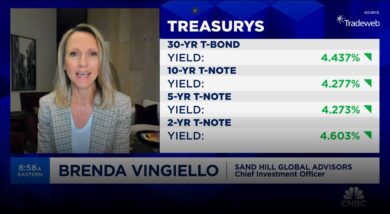Sand Hill's Chief Investment Officer, Brenda Vingiello, CFA, joins Jenny Harrington on “Halftime Report” to go over their most recent portfolio moves. Brenda's commentary begins

Writing a Happy Ending to the QE Story
“If you want your children to be intelligent, read them fairy tales. If you want them to be more intelligent, read them more fairy tales.” – Albert Einstein
Fictional narrative storytelling is one of the most memorable and effective ways to teach a lesson, capture a universal truth about the actions and consequences of human behavior, or provide an instructive analogy for a real situation. Aesop wrote short fables with plots involving a silly mistake or a cunning trick and ending with a pithy maxim. Hans Christian Andersen wrote graceful fairy tales that artfully poked fun at vanity. And the Brothers Grimm collected folk stories in the 19th Century, often with dark undercurrents that captured the rapt attention of the reader, enhancing their effectiveness as a teaching tool.
Reflecting on the economic recovery over the past four years, many of their famous fairy tales come to mind. Certainly our economy’s exceptional rise in this period is a Cinderella story of sorts. The heroine’s perseverance against the odds and optimistic demeanor helped her outperform everyone’s expectations and rise above her circumstances. But it also didn’t hurt to have the full force of a magical godmother to get her through some of the rough patches.
In our economy’s version of this tale, the clock is beginning to strike midnight. And though the markets are still basking in the afterglow of a successful recovery, the carriage is about to become a pumpkin, the footmen, mice – and it’s time to anticipate the morning after the ball with the inescapable return to normalcy…specifically the normalization of monetary conditions.
The Federal Reserve has concluded the monetary fairy dust is no longer needed and Cinderella should be able to figure it out from here. As a result, investors have started to focus on the implications of long anchored interest rates once the Federal Reserve’s bond-buying program known as Quantitative Easing (QE) comes to an end.
Fairy tale analogies are not new to us. For many years, we ourselves described the modest economic recovery since 2009 as a Goldilocks environment of 2-3% economic growth: one that was “not too hot, not too cold,” a post-crisis period of moderate growth and low inflation. We felt that economic growth would persist despite the necessary deleveraging pressures and structural headwinds that we needed to work through – and despite investor jitters, would create a positive investment environment for most asset classes. And indeed, this has been a period of significant outperformance for both stocks and bonds, driven by improving economic fundamentals and a calming of the dark undercurrent of psychology that persisted in the aftermath of the financial crisis.
Most importantly during this period, the housing sector, by design, has been buoyed by these actions. The story of The Three Little Pigs may teach the sensibility of proper real estate investment, but better building materials aside, even the straw house has been a good investment over the last several years. But real estate, one of the drivers of our economic recovery, will now be facing higher mortgage rates, which will likely slow the positive momentum in that sector over the course of the year.
The environment we find ourselves in now is perhaps best characterized by the story of The Little Red Hen, whereby the private sector keeps working despite the general ineffectiveness and restrictions of her surroundings. Indeed, the persistent productivity of business underpins the Fed’s confidence in outcomes from here. Housing, once a major drag on growth, has seen price increases and building volumes surge. Auto sales are also recovering. Employment continues to make gains and measures of income have started to grow again. And the banks are better capitalized.
But there are still a lot of frogs to kiss in this landscape. The risk today is that stocks are far more exposed to the global economy than in the past. Slowing growth in the emerging and developed worlds, a credit squeeze in China, and stagnant prospects in the Eurozone hardly represent a favorable backdrop for stocks. And the pending reduction in QE, which has been so important for asset prices, will also remove that long standing safety net. So what should we expect from here?
Well, the intermediate environment will be one of transformation, where stocks and bonds most closely resemble the story of Beauty and the Beast: the lead character (stocks) remains intoxicatingly beautiful if sometimes volatile, while the other (bonds) stays a little hairy for a bit before returning to its original prince-like state.
Beyond fairy tales, history shows that equities tend to prosper over time when interest rates are rising, because higher borrowing costs have historically reflected a stronger economy. However, during times of transition, it is not unusual for stocks to fall while bond yields rise at turning points for Federal Reserve policy. And although bonds continue to play an important role in any portfolio, we have likely witnessed the long anticipated end of the great 32-year bull market in bonds. So how do you position portfolios in such an interim backdrop?
While the story of Jack and the Beanstalk – where a boy trades a cow for a handful of beans and eventually makes a fortune off the deal – may be true for a select few whose risky undertakings pay off handsomely, it is not as viable an investment strategy as recognizing the value of consistent, disciplined execution as taught by the story of the Tortoise and the Hare. We believe most clients will be well-served by a balanced portfolio and rebalancing between growth and capital preservation assets as volatility creates opportunity.
Despite our best efforts, in reality the future remains unwritten. Perhaps the story of Little Red Riding Hood is most apt as it has at least four different endings. The darkest one, where one delivers the economic goodies, but the wolf ends up eating both the goodies and grandma (an inflationary ending) – leaving Red wondering whether the trip ever should have been undertaken in the first place – looks highly unlikely to unfold, thanks to the expertise of our story tellers.
We actually do expect a happy ending to the story of our economic recovery. Economic growth will likely accelerate in 2014 after we work through the challenges of the sequestration and tax law changes this year. And just as in the story of the Elves and the Shoemaker, your elves at Sand Hill Global Advisors will be working hard on your behalf to position your portfolio for the continued recovery, allowing you to hopefully sleep well throughout the night.
Articles and Commentary
Information provided in written articles are for informational purposes only and should not be considered investment advice. There is a risk of loss from investments in securities, including the risk of loss of principal. The information contained herein reflects Sand Hill Global Advisors' (“SHGA”) views as of the date of publication. Such views are subject to change at any time without notice due to changes in market or economic conditions and may not necessarily come to pass. SHGA does not provide tax or legal advice. To the extent that any material herein concerns tax or legal matters, such information is not intended to be solely relied upon nor used for the purpose of making tax and/or legal decisions without first seeking independent advice from a tax and/or legal professional. SHGA has obtained the information provided herein from various third party sources believed to be reliable but such information is not guaranteed. Certain links in this site connect to other websites maintained by third parties over whom SHGA has no control. SHGA makes no representations as to the accuracy or any other aspect of information contained in other Web Sites. Any forward looking statements or forecasts are based on assumptions and actual results are expected to vary from any such statements or forecasts. No reliance should be placed on any such statements or forecasts when making any investment decision. SHGA is not responsible for the consequences of any decisions or actions taken as a result of information provided in this presentation and does not warrant or guarantee the accuracy or completeness of this information. No part of this material may be (i) copied, photocopied, or duplicated in any form, by any means, or (ii) redistributed without the prior written consent of SHGA.
Video Presentations
All video presentations discuss certain investment products and/or securities and are being provided for informational purposes only, and should not be considered, and is not, investment, financial planning, tax or legal advice; nor is it a recommendation to buy or sell any securities. Investing in securities involves varying degrees of risk, and there can be no assurance that any specific investment will be profitable or suitable for a particular client’s financial situation or risk tolerance. Past performance is not a guarantee of future returns. Individual performance results will vary. The opinions expressed in the video reflect Sand Hill Global Advisor’s (“SHGA”) or Brenda Vingiello’s (as applicable) views as of the date of the video. Such views are subject to change at any point without notice. Any comments, opinions, or recommendations made by any host or other guest not affiliated with SHGA in this video do not necessarily reflect the views of SHGA, and non-SHGA persons appearing in this video do not fall under the supervisory purview of SHGA. You should not treat any opinion expressed by SHGA or Ms. Vingiello as a specific inducement to make a particular investment or follow a particular strategy, but only as an expression of general opinion. Nothing presented herein is or is intended to constitute investment advice, and no investment decision should be made based solely on any information provided on this video. There is a risk of loss from an investment in securities, including the risk of loss of principal. Neither SHGA nor Ms. Vingiello guarantees any specific outcome or profit. Any forward-looking statements or forecasts contained in the video are based on assumptions and actual results may vary from any such statements or forecasts. SHGA or one of its employees may have a position in the securities discussed and may purchase or sell such securities from time to time. Some of the information in this video has been obtained from third party sources. While SHGA believes such third-party information is reliable, SHGA does not guarantee its accuracy, timeliness or completeness. SHGA encourages you to consult with a professional financial advisor prior to making any investment decision.
Other Posts By This Author
- – A New Year’s Toast to the Silicon Valley Entrepreneur
- – How I Learned to Love the Bot
- – Thank You for Your Partnership
- – The Coming Deglobalization
Related Posts







